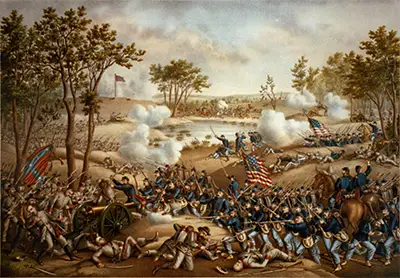The Battle of Cold Harbor
The Battle of Cold Harbor was a resounding victory for Confederate troops during the American Civil War. It took place on the same ground as another battle three years before. 
The Overland Campaign launched by the Union's top commander, Ulysses S. Grant, had targeted Richmond, aiming to capture the Confederate capital while also aiming to significantly reduce the strength and capability of the Army of Northern Virginia, led by Gen. Robert E. Lee. Lee's army and the Union's main eastern force, the Army of the Potomac, had clashed at the Wilderness and at Spotsylvania. Both battles resulted in significant casualties for both armies. The result both times was a Union sidestep and then a further advance toward Richmond. On May 31, Grant ordered the cavalry of Maj. Gen. Philip Sheridan to take control of Old Cold Harbor, a key crossroads on the road to Richmond, 10 miles northeast of the capital. When they arrived, they found it occupied by a force of Confederate cavalry and infantry. Sheridan's cavalry succeeded in driving the Confederates out of the crossroads, in the vicinity of the 1862 Battle of Gaines' Mill, part of the Battle of the 7 Days. The following day, a small Confederate attempt to retake the crossroads failed to dislodge the Union troops there. A Union attack later in the day enjoyed more success, but a Confederate counterattack negated that advantage and positions were very much the same as they were at the beginning of the day. Reinforcements poured in on both sides. 
Grant, with 108,000 troops at his disposal, ordered a large-scale attack for dawn on the following day. Various communication breakdowns and misadventures bedeviled the Union command structure, and no attack was forthcoming that day. Taking advantage of the lull in the fighting, Confederate troops numbering 62,000 dug in deeper and shored up their defenses tightly and smartly. On June 3, the next Union attack came. Nearly 50,000 strong, it rammed itself at the well entrenched Confederate defenders. In less than an hour, 7,000 Union men lay dead. The range and method of the defensive weaponry was so devastating that Union troops could not even retreat effectively; rather, they dug trenches and climbed in. No attack came the next day. Grant sent a series of messages to his Confederate counterpart, Gen. Robert E. Lee, appealing for a cease-fire during which troops could collect their wounded, who still lay on the field of battle. No fighting occurred as the days dragged on, with no cease-fire forthcoming. Three days later, both commanders agreed on a two-hour truce. By that time, most of the unrecovered wounded had died. Deciding that further attacks would be just as futile, Grant gave the order to move out. The next destination for the Army of the Potomac was the rail junction city of Petersburg. Union casualties for the Battle of Cold Harbor were 12,737 (1,844 dead, 9,077 injured, 1,816 missing or captured); Confederate casualties were 4,595 (83 dead, 3,380 injured, 1,132 missing or captured). |
|
Social Studies for Kids
copyright 2002–2024
David White




